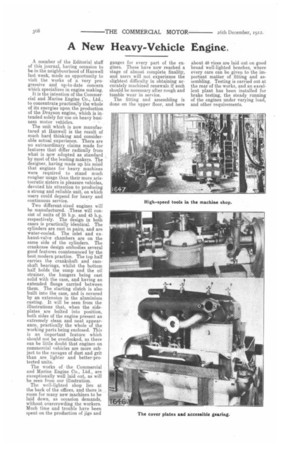A New Heavy-Vehicle Engine.
Page 12

If you've noticed an error in this article please click here to report it so we can fix it.
A member of the Editorial staff of this journal, having occasion to be in the neighbourhood of Hanwell last week, made an opportunity to visit the works of a very progressive and up-to-date concern which specializes in engine making. It is the intention of the Commercial and Marine Engine Co., Ltd., to concentrate practically the whole of its energies upon the production of the Drayson engine, which is intended solely for use on heavy business motor vehicles.
The unit which is now manufactured at Hanwell is the result of much hard thinking and considerable actual experience. There are no extraordinary claims made for features that differ radically from what is now adopted as standard by most of the leading makers. The designer, having made up his mind that engines for heavy machines were required to stand much rougher usage than their more aristocratic sisters in pleasure vehicles, devoted his attention to producing a strong and reliable unit, on which users could depend for heavy and continuous service.
Two different-sized engines will be manufactured. -These will consist of units of 35 h.p. and 45 h.p. respectively. The design in both cases is practically identical. The cylinders are cast in pairs, and are water-cooled. The inlet and exhaust-valve chambers are on the same side of the cylinders. The crankcase design embodies several good features countenanced by the best modern practice. The top half carries the crankshaft and camshaft bearings, whilst the bottom half holds the sump and the oil strainer, the hangers being cast solid with the case, and having an extended flange carried between them. The starting clutch is also built into the case, and is covered by an extension in the aluminium casting. It will be seen from the illustrations that, when the sideplates are bolted into position, both sides of the engine present an extremely clean and neat appearance, practically the whole of the working parts being enclosed. This is an important feature which should not be overlooked, as there can be little doubt that engines on commercial vehicles are more subject to the ravages of dust and grit than are lighter and better-protected units.
The works of the Commercial and Marine Engine Co., Ltd., are exceptionally well laid out, as will be seen from our illustration.
The well-lighted shop lies at the back of the offices, and there is room for many new machines to be laid down, as occasion demands, without overcrowding the workers. Much time and trouble have been spent on the production of jigs and gauges for every part of the engines. These have now reached a stage of almost complete finality, and users will not experience the slightest difficulty in obtaining accurately machined renewals if such should be necessary after rough and tumble wear in service.
The fitting and assembling is done on the upper floor, and here about 40 vices are laid out on good broad well-lighted benches, where every care can be given to the important matter of fitting and assembling. Testing is carried out at the rear of the works, and an excellent plant has been installed for brake testing, the steady running of the engines under varying load, and other requirements.




















